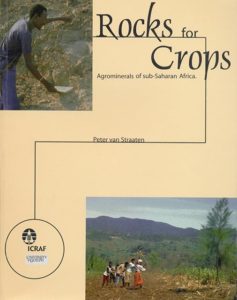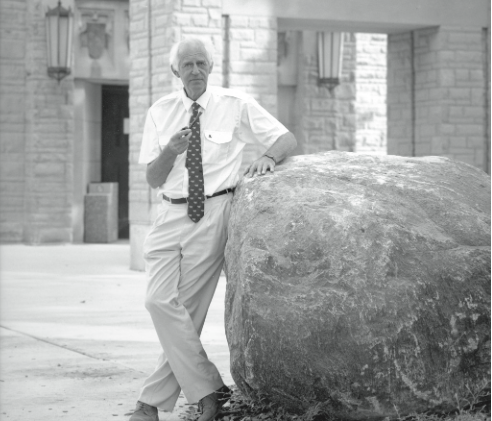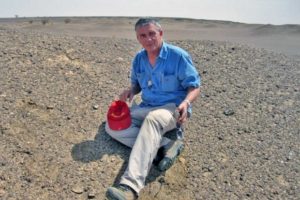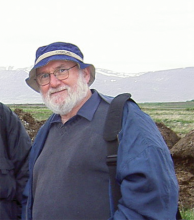Agrogeology: Geology in the Service of Agriculture
Prof. William Fyfe: Photo from the Earth Science Department of University of Western Ontario.
Farmers have long recognized the importance of soil health in delivering bountiful harvests and nutritious food. A healthy soil hosts a diverse community of microorganisms and provides an array of nutrients; it requires aeration and sufficient water supply for plants.[2] Yet soils around the world are increasingly degraded by poor land management and industrial agriculture. Fortunately, solutions to this problem can be found in agrogeology.
Agrogeology is “geology in the service of agriculture,” in the memorable words of Professor Peter van Straaten, one of the primary figures in the resurgence of agrogeology. Agricultural soils require the right balance of minerals, so geology, which studies minerals, can tell us a great deal about healthy soils for better agriculture. Researchers and farmers continue to expand our knowledge of agrogeology, revealing the potential of rocks to restore soils and producing practical applications around the world.
Agrogeology and its History
Professor Van Straaten’s important work Rocks for Crops (2002) describes the nature of agrogeology as “a study of geological processes that influence the distribution and formation of soils and the application of geological materials in farming and forestry systems as means of maintaining and enhancing soil productivity for increased social, economic and environmental benefits.”[3] Agrogeology has the same ambitious goals as agroecology (discussed in a previous article), but maintains a specific focus on minerals that can maintain agricultural ecosystems.[4]
Agrogeology first rose to prominence in the 19th century when scientists realized the potential of harnessing natural minerals to fertilize soils.[5] Work in the field was at first piecemeal, even lacking standard terminology. The First International Agrogeological Conference in 1910 settled several issues, including settling on the term “agrogeology.”[6] From there, the study of agrogeology continued as part of geology in the first half of the 20th century, and eventually became more closely associated with soil sciences and agronomy.[7]
 The field eventually fell out of favor, however. At first, agrogeology stalled due to the cost and difficulty of grinding rock materials down to fine, evenly-sized particles useful for fertilizers. Once that issue was addressed, the Green Revolution in the 1970s quickly made artificial fertilizers the new norm.[5] Chemistry dominated agricultural research.
The field eventually fell out of favor, however. At first, agrogeology stalled due to the cost and difficulty of grinding rock materials down to fine, evenly-sized particles useful for fertilizers. Once that issue was addressed, the Green Revolution in the 1970s quickly made artificial fertilizers the new norm.[5] Chemistry dominated agricultural research.
In the 1970’s, momentum started to change in favor of agrogeology with the works of researchers like the late Professors William Fyfe, Ward Chesworth, and later Peter Van Straaten. William Fyfe was a prominent and prolific geologist who served as the president of the International Union of Geological Scientists (IUGS), in addition to holding other important positions and winning several awards.[8] Through the latter half of his career he used his geological expertise to assist agriculture in developing nations, finding ways to reduce waste and maintain environmental stability.
Ward Chesworth, a Professor Emeritus at the University of Guelph in Canada, worked along with Fyfe in Tanzania and other parts of Africa.[9] Chesworth is one of the first scientists to propose using agrogeology as part of the Canada’s foreign aid projects. He possesses extensive experience working on the transfer of agrogeology knowledge and technology in the African continent.[10] Thanks to their influence, agrogeology is now studied in Canada, Tanzania, West Africa, the Canary Islands, Brazil, and elsewhere.
Peter Van Straaten, who is also professor emeritus at the University of Guelph, on the other hand, has worked in Africa to identify important sources of minerals for remineralization in the region. He has helped to prove that turning rocks into fertilizer can be socially and economically viable.
Agrogeology in Brazil
In Brazil, agrogeology employs remineralization as part of a broader strategy of agroecology to improve crop quantity and quality. Research in this area is championed by Dr. Othon Leonardos and his students Dr. Suzi Huff Theodoro and Dr. Eder de Souza Martins. (Watch an interview of Suzi’s work in Brazil with remineralization at Remineralizing Brazil, and see an interview with Eder at Remineralizing Brazil: A Visit to EMBRAPA)
Their work is further corroborated by research with Embrapa – the Brazilian equivalent of the USDA. Thus far Embrapa has established 12 different research centers and partnered with 12 other institutions for remineralization experiments. Every few years, Embrapa also actively participates in a Stonemeal Congress which brings together interested parties and institutions in remineralization to discuss and exchange information regarding the results of their work. Read more about the recent III Stonemeal Congress at RTE’s news section and an upcoming feature article!
In addition to active research, Brazil takes remineralization seriously enough to have laws regulating remineralization products. Just this year (2016) legislation was passed standardizing the classification of remineralization products with specific specifications, guarantees, tolerances, and registration of the packaging, labeling, and advertising of remineralization products. The Stonemeal Congress mentioned above acts as a ground for further discussions about remineralization products, which may then be suggested as future amendments or addendums to existing laws.
Because of the prominence of agroecology and agrogeology in Brazil, which has lead to extensive research and policy-making, Brazil has become the emerging leader in utilizing remineralization. Agrogeology is fulfilling its mission of conducting geology in service to agriculture, and through that is fulfilling the mission of Remineralize the Earth to remineralize soils worldwide.
Zu Dienle Tan recently graduated from the University of Michigan with a Master’s degree in natural resources and environment. She specializes in conservation ecology and is passionate about biodiversity conservation, agroecosystems and sustainable development.
References
[1] “Soil Quotations.” USDA Natural Resources Conservation Services Soil, n.d. Web. 02 Aug. 2016. <http://www.nrcs.usda.gov/wps/portal/nrcs/detail/soils/edu/college/?cid=nrcs142p2_054312>.[2] FAO 2008. An international technical workshop Investing in sustainable crop intensification The case for improving soil health. Integrated Crop Management Vol.6-2008. FAO, Rome: 22-24 July 2008. <http://www.fao.org/agriculture/crops/thematic-sitemap/theme/spi/soil-biodiversity/the-nature-of-soil/what-is-a-healthy-soil/en/>
[3] Straaten, Peter Van. Rocks for Crops: Agrominerals of Sub-Saharan Africa. Nairobi: ICRAF, 2002. Print.
[4] Straaten, Peter Van. “Untitled Document.” Farming with Rocks and Minerals: Challenges and Opportunities. N.p., n.d. Web. <http://www.uoguelph.ca/rocks/news/abstracts/abs01.htm>.
[5]Strauss, Stephen. “Fertilizing with rocks.” Technology Review Apr. 1987: 11+. Academic OneFile. Web.<http://go.galegroup.com.proxy.lib.umich.edu/ps/i.do?p=AONE&u=lom_umichanna&id=GALE|A5014601&v=2.1&it=r&sid=summon&userGroup=lom_umichanna&authCount=1>
[6] Russell, E. J. “The First International Agrogeological Conference.” Nature. N.p., 1 Aug. 1910. Web. <http://www.nature.com.proxy.lib.umich.edu/nature/journal/v84/n2127/pdf/084157a0.pdf>.
[7] Gill, Joel. “Some Thoughts on Agrogeology.” BLOG: Geology for Global Development: Guest Blog: Some Thoughts on Agrogeology… N.p., 5 Oct. 2011. Web. 01 Aug. 2016. <http://geo-development.blogspot.com/2011/10/guest-blog-some-thoughts-on-agrogeology.html>.
[8] http://what-when-how.com/earth-scientists/fyfe-william-s-earth-scientist/
[9] http://www.earthmagazine.org/content/ward-chesworth
[10] media.eurekalert.org/aaasnewsroom/2004/2Chesworth-Bio.doc
Support us on Patreon
Thank you for joining us today! Please become a member of RTE and support us on Patreon. Unlike many larger organizations, we work with a team of determined and passionate volunteers to get our message out. We aim to continue to increase the awareness of remineralization to initiate projects across the globe that remineralize soils, grow nutrient dense food, regenerate our forests’ and stabilize the climate – with your help! If you can, please support us on a monthly basis from just $2, rest assured that you are making a big impact every single month in support of our mission. Thank you!










Philipp Swoboda
October 31, 2018 (9:39 am)
I m doing research on rocks for crops for several years now, and would be interested in the file “Strauss, Stephen. “Fertilizing with rocks.” Technology Review Apr. 1987”, which is regretably not available by the link any more, could you maybe help me out?
best Philipp Swoboda
Philipp Swoboda
October 31, 2018 (9:40 am)
Dear Dienle Tan,
Very neat and interesting article !
I m doing research on rocks for crops for several years now, and would be interested in the file “Strauss, Stephen. “Fertilizing with rocks.” Technology Review Apr. 1987”, which is regretably not available by the link any more, could you maybe help me out?
best Philipp Swoboda
Joanna Campe
October 31, 2018 (10:08 am)
Zu Is no longer volunteering with us, but I will see what I can do to help you with this. Please send me an email as a reminder!
Joanna at RTE
Philipp Swoboda
October 31, 2018 (11:16 am)
Dear Joanna – thx for the fast reply -I will : )
best, Philipp
M Abid
April 7, 2022 (4:25 am)
I am a geoscientist I want to start my research in agro geology is it possible for you to share a list of professors working in this field thanks
Joanna Campe
May 15, 2022 (10:04 am)
Hi! I would like to respond in detail. Can you send an email to jcampe@remineralize.org? Thanks!